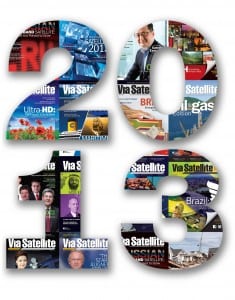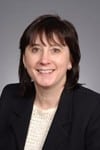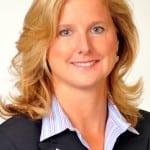Latest News
 2013 has been a banner year for the satellite industry with companies performing well and progressive next generation strategies starting to take shape. We have seen Eutelsat acquire Satmex in a deal worth more than $1 billion; witnessed the launch of the first four O3b satellites; and before the end of the year, we may well see SpaceX launch the SES 8 satellite, another major landmark for the industry.
2013 has been a banner year for the satellite industry with companies performing well and progressive next generation strategies starting to take shape. We have seen Eutelsat acquire Satmex in a deal worth more than $1 billion; witnessed the launch of the first four O3b satellites; and before the end of the year, we may well see SpaceX launch the SES 8 satellite, another major landmark for the industry.
In our annual roundtable we talk to a variety of key executives about the main talking points of the year. Taking part in this edition are: Paul Brown-Kenyon, CEO, Measat Satellite Systems; Mary Cotton, CEO, iDirect; Jay Monroe, Chairman and CEO, Globalstar; Yuri Prokhorov, director general, RSCC; Kay Sears, president, Intelsat General; and Morten Tengs, CEO, Telenor Satellite Broadcasting (TSBc).
VIA SATELLITE: There has been a lot of industry consolidation this year (Eutelsat/Satmex, Arabsat/Hellas-Sat, Optus being up for sale). Have you been surprised by this? Do you expect more to come in 2014?
Brown-Kenyon: I think consolidation is natural given the economics of the industry. There have always been challenges to consolidation on the regulatory side. I think over time these will be addressed and you will see more happening. I believe there will be more consolidation in 2014. We saw a couple of surprises this year and I think in the future you will see it continuing. The underlying trend is building scale; being an operator with a couple of satellites isn’t viable in this industry.
Cotton: There’s no doubt our industry has been in the midst of a major transition this past year. With the tremendous expectations for HTS, organizations have been taking a hard look at their growth strategies, and aligning themselves to secure the best possible position to capitalize on growth opportunities, and gain a competitive edge. This has spurred a lot of these big announcements.
I wouldn’t be at all surprised to see more consolidation in 2014, given the substantial projections in global market growth being driven by HTS. More importantly, I see 2014 as the year when we begin to gain a good sense of what approaches and business models are proving most successful.
Monroe: I haven’t been surprised. I think in an industry like FSS, scale and a broad product offering is very important. When companies get together, particularly when they have different sizes, such as Eutelsat and Satmex, it is about scale, and providing services at a lower cost or higher margin. So, this makes more sense to me. They maybe some more consolidation in the FSS space, but I am not close enough to that space to say whether it will happen.
Sears: The specific projects you reference have been in and out of processes for several years. We’d rather not speculate on what other assets might come to market over the next year.
Prokhorov: I am not surprised because the process is quite natural for smaller regional operators. The satellite business is a risky one; insurance is a prominent cost item for any operator, the price is very high for a marketing error or launch failure. What happens to such operators once the satellite has been launched? For economic reasons, or due to their inability to diversify regional businesses, they have to seek alliances with larger players; this is quite normal. Competition among satellite operators makes it necessary to sell not so much the capacity but value-adding services to their end customers. Big players command more capabilities and assets to this end. Today, operating a fleet of one or two satellites is more risky than a fleet of 20. Therefore it is only natural that a larger player comes in and gets a ready-made regional business complete with orbital assets.
Tengs: Consolidation in the industry came as no surprise. There had been something of a hiatus in mergers and acquisitions (M&A) activity during the global recession, so to an extent there was probably pent up pressure for further consolidation.
There are two main characteristics in the satellite industry that encourage this view: firstly, although it is highly concentrated with the big three or four having a large market share, there remain a large number of smaller operators representing potential “targets.” Secondly, significant “new build” organic growth is not easy; it is not easy to open up a new orbital slot even when the rights exist, so growth by acquisition into new regions or new orbital locations is the obvious route to take.
VIA SATELLITE: O3b has launched this year, and SpaceX may yet complete its first commercial satellite launch. How would you assess the impact of these two companies on the satellite industry?
Brown-Kenyon: What SpaceX has done is exciting. I believe this company will have a major impact on the launch industry going forward. There are not a lot of options for launch vehicles today: you have the Ariane launch vehicle, which has proven its reliability but is priced at the upper end of the market; and then you also have a number of Russian and Ukrainian launch vehicles, which have some reliability issues that need to be addressed. I think Elon Musk has come into the sector with a completely different mindset and produced a vehicle that I believe will be very successful. There have been delays initially but you expect that with new technology. In the medium to longer term I think it will be a great launch vehicle and it will introduce more competition in the launch market – this is good for the industry.
The jury is still out on O3b in terms of the technology and how it might impact the industry. The philosophy behind O3b is to provide broadband fiber-like connectivity to remote areas. Next year we will know more about the product and the service, and where it might impact the industry.
Cotton: As an industry matures and markets open up, you expect to see a strong burst of innovation, entirely new solutions that shift the paradigm. SpaceX and O3b have taken on solving some tough, long-standing challenges to reduce the cost of satellite deployment and capacity. These are significant developments as they will enable the industry as a whole to capitalize on the biggest growth opportunity we’ve had to date.
With SpaceX, the introduction of a new launch provider shows a bullish confidence in the satellite market. It’s also important given that launching a satellite represents one of the biggest costs and biggest risks in our business. SpaceX promises to lower both, which is a win-win for everyone across our ecosystem. More capacity, more choice.
Monroe: In the case of SpaceX, having an additional, reliable service provider is extremely important to the growth and future well-being of the industry. Perhaps, it will even encourage parties that have solely gone into the military market to re-enter the commercial marketplace, but you can’t be sure.
I consider SpaceX to be disruptive in the good sense, both in terms of the types of technology they are employing, which is designed to be extremely reliable, and at a moderate cost. As long as they put a string together of successful launches that assures their customers, I think it is a real alternative to the established launch providers.
With O3b I expect they will widen the reach of the data services. It is a different service than people have been accustomed too provided at a lower cost and in a market segment that has not really existed before, so low-latency, inexpensive, per-bit telecoms backhaul services. I think it is a terrific technology. Whether it will spawn more companies like O3b or similar is anyone’s guess, but I think it is an important additional step for satellite services. It is different, good and economical. I think SES controlling O3b is about scale and service offering.
Sears: Our industry requires constant innovation and evolution to be successful and be in position for the right opportunities. It’s hard to have much impact until you are actually in service. With respect to SpaceX, commercial operators launching multiple satellites each year need a robust source of launch providers to ensure that commercial and hosted payloads have multiple options to get to space on time. Having additional launch companies only adds to the robustness of the satellite industry, as more players will bring more competitive pricing, greater launch schedule flexibility and new opportunities for hosted payloads. These companies help demonstrate that the commercial space industry is innovative and helps maintain U.S. leadership in space.
Prokhorov: My assessment is very positive. O3b (Ka-band on medium-altitude orbits) is a good example of business diversification for a major GEO operator (SES). At RSCC, we are currently considering a project based on alternative (high elliptical) orbits to provide communications in high-latitude Arctic regions, and we are following the O3b project implementation with considerable attention.
As regards new launch systems, any competition usually brings about price reductions across the market, and for satellite operators the cost of orbiting their satellites continues to be quite significant.
Tengs: I believe the industry as a whole will benefit from greater competition and choice in the launch market and therefore a new entrant can expect to find encouragement. As such, we will watch SpaceX’s progress with interest. I think O3b will heighten awareness that the satellite industry is capable of developing competitive solutions in specific areas of the telecommunications marketplace.
VIA SATELLITE: What do you expect to be the main talking points or hot topics of our industry in 2014?
Brown-Kenyon: In our region, DTH has, and will continue to show, phenomenal growth. DTH growth in markets such as Malaysia, India and Indonesia has been constrained recently due to the lack of availability of capacity.
Secondly we are seeing increased interest in High Throughput Satellites. This is something that a number of operators in the region are focused on to understand how we can develop a viable HTS for the Asian region. There are certain challenges compared to North America and Europe.
Cotton: If 2013 was the year of HTS hype, I believe 2014 will be the defining year for execution. As the HTS vision becomes reality, we’ll be able to gauge early successes, see how some of the first programs have fared, and evaluate lessons learned.
HTS will continue to be a hot topic, especially as a number of HTS programs come to fruition in 2014 and 2015. The launch of Inmarsat’s Global Xpress service will likely be a high profile event given that it marks the first global Ka-band mobility network delivered by a single provider. In terms of execution, it will be very interesting to watch as we draw closer to launch dates for some of the bigger global launches like Intelsat EPIC and significant regional programs such as Telenor’s Thor 7.
Going into 2014, I don’t believe any organization can afford a “wait and see” approach with HTS. At the end of the day, every company must make it a top priority to demonstrate how it is executing their own unique growth strategy.
Monroe: Generally speaking, I think the industry will grow and new services will be provided. Some of those services will be orientated to mass consumer marketplaces, some will be like O3b, others will be avant-garde by today’s standards, and some will be high-speed ViaSat 1, ViaSat 2, Jupiter-style services, so these will be high-bandwidth and relatively lower cost per bit. Those are a couple of the themes.
I believe that the prices for anything that is satellite will come down, and because of that, prices will expand. When you think of industries like oil and gas, forestry, or aviation, as you see lower and lower cost equipment to address them, industries get to a tipping point, and they buy more and more services. If you think about that going beyond 2014, this cost curve continues to be a driver for a lot of different industries.
Another talking point in 2014 will be the continued terrestrialization of spectrum. You will see this concerning the LightSquared spectrum, the Globalstar spectrum, and maybe some other spectrum that is controlled by satellite companies in other parts of the globe. It is all about the FCC getting to its conclusion on the Globalstar spectrum, but I think the broad issue will be a main topic of industry chatter.
Sears: Our industry is focused on creating the next generation of satellite systems that will support a broadband infrastructure for a fully connected world – whether on land, sea or in the air. The U.S. government, and its use of commercial capacity in a budget-constrained world, will be another major topic. For example, incorporating commercial capabilities into the U.S. government’s space architectures in a collaborative way so industry can plan satellite systems that meet future U.S. government requirements anywhere in the world. Related to architecture, the important topic of acquisition reform will continue to be front and center as the government works to reduce costs and make commercial satellite capacity a long-term solution to their growing demand for high-throughput, high-speed communications worldwide.
Prokhorov: For the Russian market the hottest subject will hopefully be the seven launches of our new satellites, scheduled for 2014. RSCC’s plan for 2014 is to completely renovate its constellation with brand-new assets, fill all Russian orbital slots, fully meet the domestic demand for satellite capacity, and focus on other regional markets. As regards the rest of the world, the main talking point in 2014 will continue to be HTS.
Tengs: I think two of the main themes for discussion from 2013 will continue into 2014. Namely, what will be the impact of HTS, and will there be overcapacity in certain regions of the world? Personally, I would like to see the industry pressing for greater innovation and efficiency in the satellite manufacturer/launcher supply chain, as I think this is how in the long run we can take benefits to our customers, and improve our performance in an increasingly competitive communications marketplace.
VIA SATELLITE: Not including your own company, what would you say was the most interesting announcement you heard this year regarding the satellite industry?
Brown-Kenyon: What we are seeing in this region is a lot more “co-opetition.” One of my ex-professors at Yale (Barry Nalebuff) coined the term to describe situations where companies may be strong competitive rivals in one area, but work together in another. It is an interesting trend. It complicates the competitive landscape in many ways, but I think it is good for the industry.
Cotton: In a word: mobility. Satellite connectivity fulfills the promise of mobility, and the successes are backing that up, in the air, on land, and sea.
This year, we heard several exciting announcements from the commercial aviation industry. Major airlines are equipping their fleets with broadband systems, representing one of the most promising emerging markets for VSAT. In January, United Airlines introduced satellite-based Internet connectivity for international travel, serving trans-Atlantic and trans-Pacific routes. They expect to equip 200 aircraft with satellite by the end of this year. In April, Honeywell and Boeing signed a technology agreement to develop faster, more reliable in-flight connectivity. And in September, Gogo announced a multi-million dollar deal to provide satellite Wi-Fi in an effort to expand its services. These announcements, combined with continued growth in installations around the world, are proving that the aeronautical market will be significant.
Monroe: First I would say the continued progress of SpaceX. Secondly, I would say the launch and the problems after the launch of O3b. To me, those are two of the most interesting announcements in the areas I stay close too.
Sears: We are very pleased to see that the Air Force has extended the CHIRP research and development mission using a hosted payload on a commercial satellite. The sensor on the payload has met many key milestones and has exceeded life expectancy in orbit since its launch. This success proves that DoD hosted payloads on commercial satellites can deliver operational capability rapidly and cost-effectively, especially when compared to large programs of record. I also believe that the Pathfinder RFI recently issued by SMC is forward leaning and creative and will result in cost savings and flexibility for meeting critical mission requirements. It has continued to move the reform process forward between the Air Force and commercial industry providers.
Prokhorov: The success of HTS competing with ground-based solutions. Hughes and ViaSat continue their broadband base buildup in the United States. Avanti and Yahsat are doing well in the Middle East. Moreover, the same trend is obvious in Russia. Despite well-developed ground based communications infrastructure, satellites continue to provide the most reliable and high-speed communications link, and the satellite option fully applies to private individuals. Suffice it to say that even in Africa, where deep-sea cable is now available, satellite still demonstrates higher reliability versus cable.
Tengs: Other than the M&A announcements already mentioned, it is interesting to read about the continuous race for market position of HTS among the satellite industry.
VIA SATELLITE: While satellite broadband has made a strong impact in the United States, can Ka-band/HTS have the same impact in other parts of the world?
Brown-Kenyon: I think you are already seeing the impact of HTS in Asia with the Ipstar platform. Ipstar uses Ka-band on the feeder link and Ku-band on the service link. Thaicom and Ipstar have had some challenges since the launch of the satellite, but it is now getting traction. As an example, Measat secured the Malaysian payload of the satellite a couple of years ago and rebranded it Measat 5. As a result of our efforts, the utilization level increased from 5 percent when it was first taken to almost 50 percent today.
Taking a step back, there are three challenges to make a big Ka-band satellite (or HTS) work in this region. Firstly, you have a regulatory challenge. Unlike North America, Asia has a series of individual countries with separate regulatory regimes; some of those are relatively open, but some are closed. With HTS you need scale but having that patchwork of regulation limits your ability to develop scale. Secondly, you have an economic challenge – the ability of consumers to pay in this region is not as high as in North America. In Asia, you have a large number of different sized markets with different abilities to pay. So, getting the critical mass of consumers with the ability to pay is challenging. The third challenge is a technical one. The rainfall in Asia is significantly higher than in most North America states. It is not as easy to develop an HTS model in Asia compared to North America. I think over time those challenges will be addressed, and you will see a number of platforms deployed.
Cotton: Certainly, but I think the big opportunity is not just in the consumer market, but enterprise applications, across a variety of sectors around the globe. One of the most significant enterprise markets for HTS will be mobile backhaul. HTS will lower bandwidth costs significantly and, combined with low-cost small-cell base stations, will create a viable business case for mobile operators to expand 3G and 4G networks into remote areas in every corner of the world.
The bottom line is that HTS represents a major step forward for our industry, making it a viable mainstream communications technology for virtually any application. I believe the key is collaboration, across the entire VSAT ecosystem. Whether you’re a satellite operator, a service provider, or a ground segment and technology provider, we all have an important role to play in taking VSAT to the next level.
Monroe: They can, as long as the equipment costs go down. Obviously, if you are going to go in parts of the world where you are going to provide services to businesses that are by definition more well off than others in emerging market population, there will be good opportunities. More and more people want to be connected all of the time. Services are becoming less expensive, and people want them at broadband speed. I think the opportunities here are only in their infancy.
Sears: Intelsat believes that in order for satellite solutions to remain relevant, we must strive for higher performance and efficiency, allowing our customers to deliver higher bandwidth solutions while also differentiating their services in the marketplace. We have designed our global high throughput platform, Intelsat EpicNG, by collaborating with some of the most intensive users of satellite capacity, supporting their vision of their network 10 years out.
Prokhorov: The Ka-Sat satellite partially covers European Russia. About a year ago, jointly with Eutelsat, we began using the satellite to provide broadband services to private users in Russia in test mode.
Although it was a pilot trial, and the spacecraft coverage zones happened to be over the regions with advanced ground infrastructure, we managed to line up about 4,000 customers. This clearly points to a great demand for satellite services even in those central regions where both ground-based solutions and 3G are available. In 2014 we are planning to increase our satellite broadband offer to the remainder of Russia’s territory using our new Express-AM series satellites.
Tengs: Telenor Satellite Broadcasting (TSBc) has an HTS Ka-band payload on the Thor 7 satellite, which will be launched in 2014. I am confident that HTS will be successful, but it is not the technology as such which is the critical driver. The key is providing products and services that appeal to the customer. From our perspective, we are already experiencing considerable interest from the maritime and oil and gas customers in the products and services which we will provide. It is a combination of factors: Thor 7 has a strong footprint, the products are the right ones, and our customer relationships are strong. VS
Get the latest Via Satellite news!
Subscribe Now




